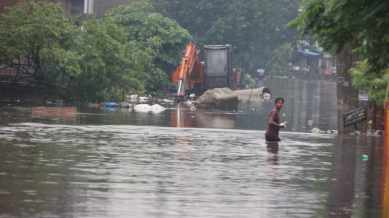Stay updated with the latest - Click here to follow us on Instagram
As Sutlej water rises, Ludhiana orders closure of dyeing and printing units
The order aims to reduce industrial wastewater discharge and ease pressure on the overwhelmed sewerage system in Ludhiana.

Continuous rain for over eight hours left Ludhiana, Punjab’s industrial hub, grappling with severe waterlogging and overflow of the Buddha nallah, which drains into the Sutlej river at the Walipur village, Monday. The city’s sewage treatment plant (STP) at Bhattian has also stopped functioning due to backflow from the Sutlej, compounding the crisis.
In view of the situation, the deputy commissioner of Ludhiana ordered the immediate closure of all dyeing, associated printing, and washing units across the city until further notice. The move is aimed at reducing industrial wastewater discharge and easing pressure on the overwhelmed sewerage system.
“There are around 350 dyeing units in Ludhiana, mainly concentrated in Bahadurke Road, Tajpur Road, and Focal Point Phase 8, apart from several scattered units,” an official said.
The common effluent treatment plants at Bahadurke Road, Focal Point, and Tajpur Road have capacities of 15 MLD, 50 MLD, and 40 MLD, respectively, and if scattered units are combined, the daily discharge of dyeing units is around 16 crores litres of water per day into the nallah, which further gets added up in the Sutlej. Dyeing units, however, claim that they discharge treated water, not effluents, directly.
Buddha nallah: pollution and overflow concerns
Buddha Nallah, a highly polluted stormwater drain carrying sewage and industrial waste, has been an environmental and health hazard for decades. It merges with the Sutlej at Walipur village, spreading pollutants downstream. During heavy rains and floods, the nallah frequently overflows, inundating low-lying areas of Ludhiana.
Experts estimate that combined discharges from organised and unorganised dyeing units amount to over 16 crore litres daily (treated as per the claims of the industry), putting additional stress on the city’s sewerage network during floods.
Interestingly, while issuing the closure order, the deputy commissioner did not specifically cite the Buddha Nallah overflow. Instead, the order cites the backflow of the Sutlej river water into the Bhattian STP as the reason.
A letter from the additional municipal commissioner to the DC highlighted that the Bhattian STP was not functioning effectively due to this backflow, resulting in surcharged sewer lines and a high risk of sewage overflow in low-lying residential areas.
As per the official order, all dyeing, printing, and washing units located on Bahadurke Road, Tajpur Road, Samrala Chowk, Industrial Area-A, Moti Nagar, and other scattered locations must remain shut until further instructions.
Despite the heavy overnight rain, several dyeing units opened Monday morning. After the DC’s order, Punjab Dyers Association representative Bobby Jindal said, “We will close the units, and the impact will start from 2 pm onwards. Otherwise also, the biofuel used to run dyeing units got wet, making operations unviable under these conditions. This shutdown will give substantial relief to the system. Even during the 2023 floods, we closed the units for two days on the DC’s orders.”